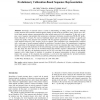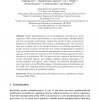62 search results - page 3 / 13 » Predicting RNA-binding sites of proteins using support vecto... |
BMCBI
2010
13 years 7 months ago
2010
Background: Flavin binding proteins (FBP) plays a critical role in several biological functions such as electron transport system (ETS). These flavoproteins contain very tightly b...
JCC
2008
13 years 7 months ago
2008
: Knowledge of structural classes is useful in understanding of folding patterns in proteins. Although existing structural class prediction methods applied virtually all state-of-t...
BICOB
2009
Springer
13 years 11 months ago
2009
Springer
Protein phosphorylation is a crucial regulatory mechanism in various organisms. With recent improvements in mass spectrometry, phosphorylation site data are rapidly accumulating. D...
CANDC
2006
ACM
13 years 7 months ago
2006
ACM
O-glycosylation is one of the most important, frequent and complex post-translational modifications. This modification can activate and affect protein functions. Here, we present ...
BMCBI
2008
13 years 7 months ago
2008
Background: Protein remote homology detection and fold recognition are central problems in bioinformatics. Currently, discriminative methods based on support vector machine (SVM) ...


